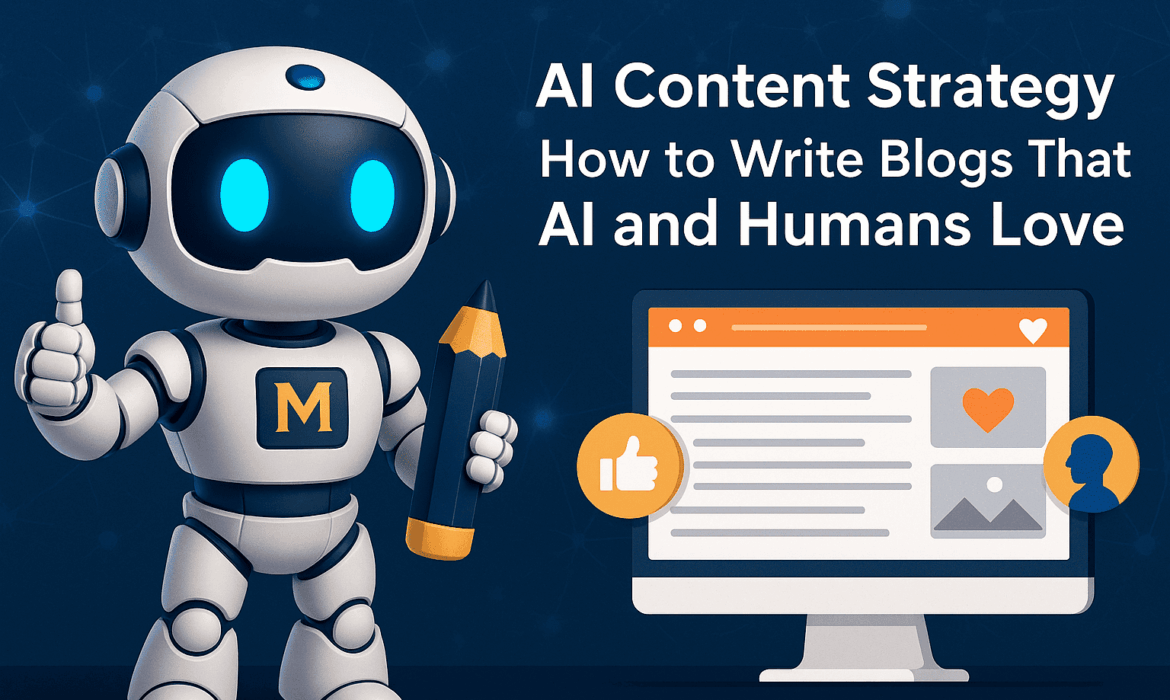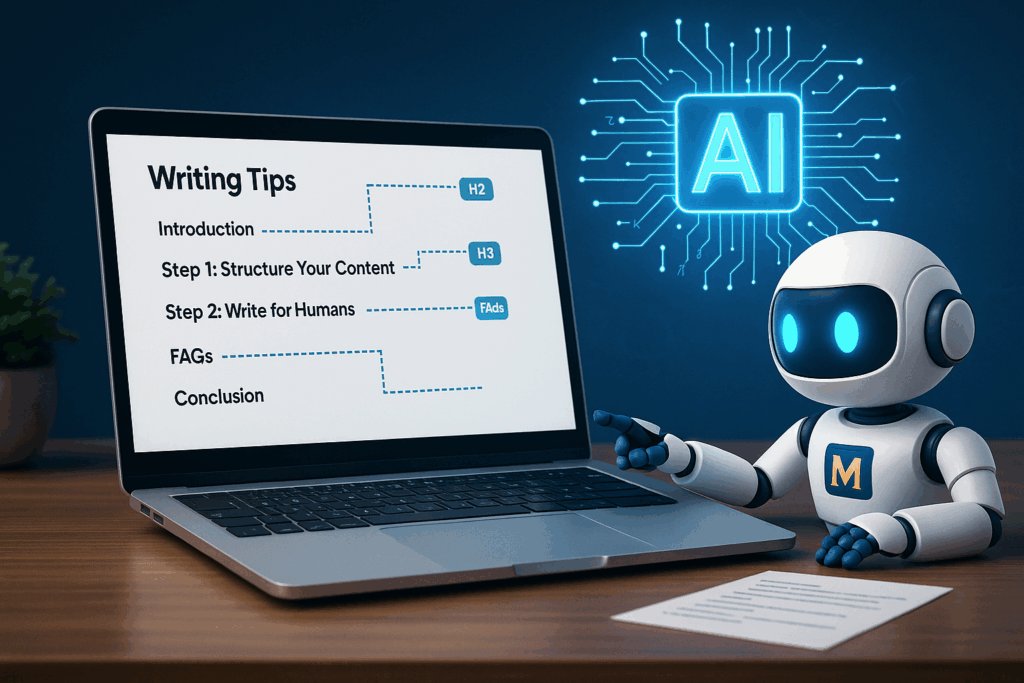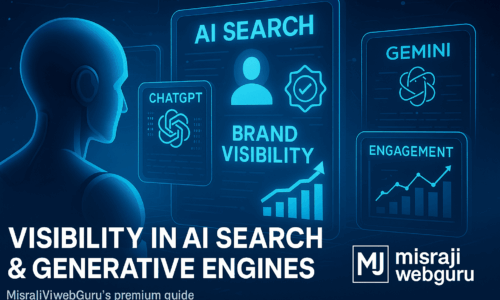
Introduction: Why I’m Writing This for You
“Write for humans, Structure for AI & Win with both.”
AI Content Strategy is the new rulebook for writing blogs that both readers and search engines love. In 2025 you’re not writing for one audience—you’re writing for humans who want clarity and connection and AI systems (like Google’s AI Overview) that decide what gets seen. At MisraJiWebGuru, I teach a simple principle: write for humans, structure for AI. Do that well and your content becomes understandable, findable, and unforgettable.
Every day, I meet professionals, freelancers, and entrepreneurs who feel lost in today’s digital landscape. They ask me:
“MisraJiWebGuru, how do I write blogs that both rank on Google and actually connect with people?”
My answer is simple: In 2025, you’re not writing for one audience anymore. You’re writing for two:
- Humans → who want clarity, stories, and trust.
- AI systems → like Google’s AI Overview, which decide whether your blog even gets visibility.
This blog is my way of supporting you—to help you understand AI Content Strategy and learn how to create blogs that AI respects and humans love.
The Struggle Professionals Face
“If people don’t stay and AI doesn’t quote—you lose twice.”
I know how frustrating it feels.
- You spend hours writing a blog, only to see no traffic.
- You follow SEO checklists, but the results are still flat.
- Sometimes, your writing feels too robotic because you’re chasing keywords.
Here’s the truth I’ve learned:
– If humans don’t enjoy your blog, they’ll leave.
– If AI can’t understand your blog, it won’t show.
AI Content Strategy is the bridge.
Step 1: Start With Intent, Not Keywords
“Keywords attract. Intent connects.”
Whenever I train writers, I tell them: Stop obsessing over keywords first.
Ask:
- What exact question is my reader asking?
- What problem are they struggling with?
- Can I provide a clear, direct answer?
Example: Instead of writing a blog stuffed with “best SEO tools 2025,” try answering:
“Which SEO tools actually save beginners time and money in 2025?”
When you write with intent, humans feel understood and AI sees relevance.
Step 2: Write Like You’re Explaining to a Friend
“Good writing doesn’t impress—it explains.”

Too often, professionals write as if they’re impressing Google. I’ve seen blogs that sound like manuals—cold and lifeless.
But blogging is like teaching a friend. Explain simply:
- Use short sentences.
- Break things into steps.
- Add analogies.
For example, when I explain AI SEO to clients, I say:
“Think of AI as a teacher’s assistant. It organizes your notes, highlights key points, and makes sure the examiner sees the right answers.”
Step 3: Structure for AI Without Losing Heart
“Format is the bridge between AI and humans.”

Here’s a secret: AI doesn’t read like humans. It scans for structure.
So, while your heart writes for people, your formatting must guide AI.
- Use headings and subheadings (H2, H3).
- Add FAQs—Google loves to pull them into AI Overview.
- Use lists and steps—machines read them easily, humans find them helpful.
This is exactly what I do at MisraJiWebGuru—we humanize the voice, but engineer the structure.
Step 4: Blend Emotion With Authority
“Data builds trust. Stories build memory.”
Humans trust stories. AI trusts facts. You need both.
✔️ Share real examples.
✔️ Add data or statistics.
✔️ Write like you mean it.

💡 For instance, I once worked with a local clinic whose blogs ranked on page one but got no clicks. Why? Google AI Overview already answered the query—and they weren’t featured.
We rewrote their blogs with AEO and AI Content Strategy:
- Direct answers.
- FAQ sections.
- Schema markup.
Within weeks, their clinic name appeared in Google AI Overview. That single placement brought more patient inquiries than months of traditional SEO.
Step 5: Keep Content Alive
“A blog isn’t finished. It’s maintained.”
A mistake I see professionals make is treating blogs like “done and dusted projects.”
But AI doesn’t like stale content. Neither do humans.

Keep updating:
- Add new examples.
- Refresh statistics.
- Rewrite FAQs as trends shift.
At MisraJiWebGuru, we maintain blogs like gardens—always trimming, always watering.
A Quick Checklist You Can Follow Today
“Strategy is not a task. It’s a habit.”
If you’re a fresher or a professional trying to improve, here’s a simple starting point:
- Research intent, not just keywords.
- Write in a teaching, conversational tone.
- Structure with headings, lists, FAQs.
- Blend emotion with data.
- Keep blogs fresh and updated.
10 FAQs About AI Content Strategy
- What is AI Content Strategy?
A way of writing blogs that satisfy both humans and AI for visibility and trust. - Do I need AI tools for AI Content Strategy?
Tools help, but mindset matters more. Write clearly and structure answers. - Why is AI Content Strategy important in 2025?
Because Google AI Overview decides if your content is seen. - Is this different from normal content writing?
Yes—this blends human emotion with AI structure. - Do I need technical skills?
Not much. Schema helps, but clarity is the foundation. - Can beginners apply this?
Absolutely. Start with intent and FAQs. - Does keyword stuffing work anymore?
No. It drives humans away and confuses AI. - How do I know if my blog is AI-friendly?
Check if your answers are direct, structured, and updated. - Does this apply only to blogs?
No—works for service pages, product descriptions, FAQs, and more. - Why choose MisraJiWebGuru for this?
Because we write with a human heart and AI precision—and that’s what wins in 2025.
Conclusion: My Message to You
“Blogs are not just words. They are bridges—between you, your audience, and AI.”

If you’re reading this as a professional, fresher, or entrepreneur, here’s what I want you to remember:
- Write for humans → They feel your brand.
- Structure for AI → It gives you visibility.
- Blend both → You build authority.
At MisraJiWebGuru, I don’t just optimize websites—I guide people like you to adapt, learn, and thrive in this new age of AI-driven search.
And together, we’ll make sure your brand isn’t just another option—it’s the answer.



